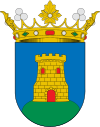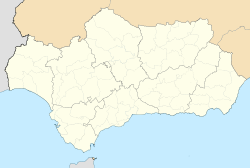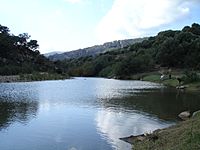Jimena de la Frontera facts for kids
Quick facts for kids
Jimena de la Frontera
|
|||
|---|---|---|---|

View of Jimena from one of the fields surrounding it.
|
|||
|
|||
| Country | |||
| Autonomous community | |||
| Province | |||
| Comarca | |||
| Municipality | |||
| First settled | 8th century BCE | ||
| Area | |||
| • Total | 345.66 km2 (133.46 sq mi) | ||
| Elevation | 99 m (325 ft) | ||
| Population
(2022)
|
|||
| • Total | 6,681 | ||
| • Density | 19.3282/km2 (50.060/sq mi) | ||
| Demonym(s) | Jimenato, ta | ||
| Time zone | UTC+1 (CET) | ||
| • Summer (DST) | UTC+2 (CEST) | ||
| Postal code |
11330
11339 (Los Ángeles) |
||
| Dialing code | (+34) 956 | ||
| Website | jimenadelafrontera.es | ||
Jimena de la Frontera is a historic town in the province of Cádiz, Spain. About 6,700 people live here as of 2022. It includes the main town of Jimena de la Frontera, plus smaller towns like Los Ángeles and San Pablo de Buceite.
The town is in the eastern part of the province. It sits on the A-405 road, which connects San Roque and Ronda. Jimena is very close to the border between the provinces of Málaga and Cádiz. It is located between the Serranía de Ronda mountains and the Bay of Algeciras. This area is home to one of the most important Mediterranean forests in southern Europe: the Los Alcornocales Natural Park. Almost two-thirds of Jimena's land is part of this amazing park.
Contents
A Look at Jimena's History
Ancient Beginnings
People have lived in the area around Jimena de la Frontera for a very long time. We know this from ancient cave paintings and remains found in caves. These date back to the Stone Age. One special place is the Laja Alta cave, which has unique paintings of ships from the Bronze Age. These are the only known maritime scenes from that time in the Iberian Peninsula.
The ancient Phoenician city of Oba is thought to be where Jimena is today. Coins from Oba have been found with writing on them. During Roman times, Jimena was an important place for trade and strategy. It was a good defensive spot because it was protected by hills but also close to the Strait of Gibraltar. Later, the Visigoths and then the Byzantines used it as a military post.
Muslim Rule and the Reconquista
When Muslims arrived in the 8th century, they strengthened the town's defenses. They called it Xemina, which later became Jimena. The town was under the control of the Marinids and then the Nasrid kingdom of Granada. It was a "frontier" town, meaning it was on the border between Muslim and Christian lands. This is why it's called de la Frontera.
In 1431, Christian forces led by Pedro García de Herrera conquered Jimena. But the town kept changing hands between Muslims and Christians for a while. In 1456, King Enrique IV finally conquered it for good. He gave it to Beltrán de la Cueva. The town was then rebuilt and new people moved in. In 1510, it was sold to the powerful Casa de Medina Sidonia family.
Jimena's soldiers helped in the final conquest of Granada. Because of their loyalty, the Catholic Monarchs gave Jimena special titles in 1493 and 1498.
Later History
After the wars ended, Jimena became less about military defense and more about farming. People grew cereals and legumes, raised animals, and used the forests. This made the town grow, and people started living outside the castle walls.
In the 18th century, Jimena became a military spot again because of conflicts with the English over Gibraltar. A large factory was built to make weapons, but it eventually closed because it was too expensive.
During the Spanish War of Independence, Jimena saw many battles. This caused a lot of damage and loss of historical records. In the 19th century, Jimena gained independence from the Duke's power. In 1879, King Alfonso XII of Spain officially made it a city.
In recent times, Jimena's population has included more British people who have moved there. The town is easy to reach by road and train. The railway station is in Los Ángeles, just outside the town.
Exploring Jimena's Landmarks
The Castle of Jimena
The Castle of Jimena de la Frontera was built by the Moors around 750 CE. It was a very important military spot. From the castle, you can see all the way to Gibraltar! It's believed the castle was built on top of old Roman ruins. It was made using limestone from the local area.
The castle is the most famous building in Jimena. It was declared an important cultural monument in 1931. The castle has long, irregular walls that follow the shape of the hill. It has watchtowers and a special tower called the Torre del Reloj. Inside the castle, there's also the Alcázar, which was rebuilt after the Christians took over. It has a round main tower.
Ancient Art and History
- Cave paintings at the La Laja Alta Cave: This cave shows amazing prehistoric art. The Laja Alta cave has paintings of people, animals, and symbols. It also has a unique scene of eight ships, painted in red and black. This makes it special because it's the only cave with such detailed maritime scenes. These paintings are thought to be from before 4000 BCE.
- Necropolis of Buceite: Near San Pablo de Buceite, there are old burial sites from the Byzantine era. In the 1950s, a Byzantine tomb was found with a clay pot and a bronze oil lamp. These items are now in the Municipal Museum of San Roque.
- Baño de la Reina Mora (Bath of the Moorish Queen):
Behind the castle, you can find remains of what was probably a Mozarabic church carved into the rock. It looks like a bath, which is why it's called the "Bath of the Moorish Queen." It was most likely a large font used for baptisms by early Christians.
- Royal Artillery Factory: This factory was built in the 18th century to make weapons. It was the second large iron factory in Andalusia. It used iron from a nearby mine and wood from the forests for fuel. The factory helped supply weapons during the Great Siege of Gibraltar. You can still see some remains of the factory along the Hozgarganta River.
Religious Buildings
- Sanctuary of Our Lady Queen of Angels:
This beautiful sanctuary is about two kilometers from the town center. It was built in the late 15th century and updated in the 17th century. It used to house a community of Franciscans. After the English took Gibraltar, it became a safe place for nuns who fled from there. The sanctuary has a main chapel and a lovely cloister with a garden. The statue of the Virgin Mary inside is very old and made of painted stone.
- Bell tower of the Church of Our Lady Crowned: This bell tower stands alone in the Plaza de la Constitución. It's the only part left of the old Church of Nuestra Señora la Coronada. The church was very old and eventually torn down in 1946, but the bell tower was saved. It's a tall, strong tower with openings for bells at the top.
- Church of Our Lady of Victory: This church is also known as the old Convent of Saint Anne. It has two parts and is connected to an old convent. It has a modern look with a simple front and an outdoor patio. The church got its current name from the patron saint of Málaga, Our Lady of Victory.
- Church of Mercy: Near the castle, you can see the remains of an old Gothic church called Iglesia de la Misericordia. It has stone ribs and arches. This church was probably updated in the 16th century, adding Renaissance details. Today, it serves as a tourist office.
- Chapel of Solace: The Ermita del Consuelo is an old chapel in the center of Jimena. It's no longer used for religious services. It has a brick front and a rounded arch.
Nature and Geography
Jimena de la Frontera is in a special location. It's in the northern part of fertile plains, with the Atlantic Ocean and Mediterranean Sea to the south. The town is in the middle of the Los Alcornocales Natural Park and sits on a hill called Cerro de San Cristóbal. This means it has many different kinds of landscapes.
Jimena has a mild Mediterranean climate. It gets about 3,000 hours of sunshine each year, and average temperatures are between 18 and 20 degrees Celsius (64-68 degrees Fahrenheit). It gets more rain than other parts of southern Spain because of the winds from the Strait of Gibraltar. This rain helps keep the rivers flowing.
Three important rivers flow through Jimena: the Guadiaro, the Guadarranque, and the Hozgarganta. The Hozgarganta is the most important. It flows through the town and is known for being wild and untouched. It has a lot of healthy animals and plants, and in some places, it's covered by a thick forest. It's one of the last untouched rivers in Spain.
Festivals
Jimena de la Frontera celebrates several fun festivals throughout the year:
- Town Carnival - February (sometimes March)
- Agricultural Fair - Second week of May
- Annual Village Fair - Second week of August
- Devotion to the Reina de los Angeles - First week of September
- Festival de Música de Jimena de la Frontera - Second week of July
Gallery
See also
 In Spanish: Jimena de la Frontera para niños
In Spanish: Jimena de la Frontera para niños














